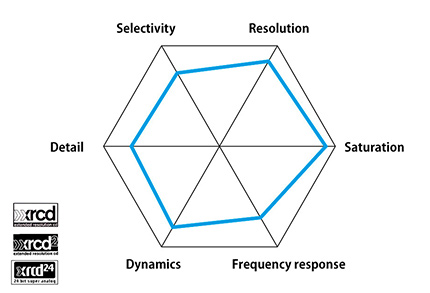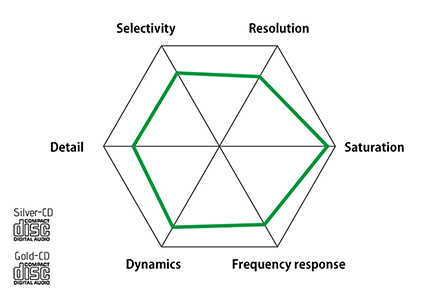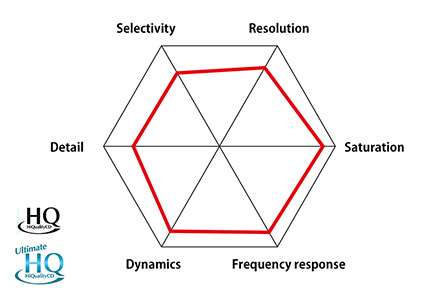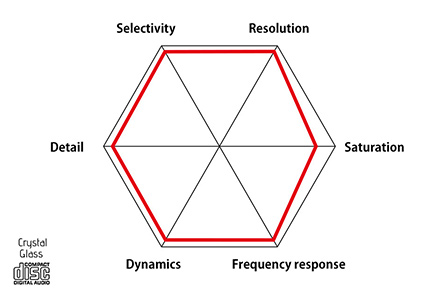No. 248 January 2025
- COVER REVIEW: Gigawatt POWERMASTER 25 ANNIVERSARY EDITION ⸜ AC power conditioner » POLAND
- KRAKOW SONIC SOCIETY № 149: High Fidelity Presents: ART FARMER: Art Farmer in Wrocław » POLAND/Krakow
- REVIEW: Audio Phonique DESIRE SP ⸜ speaker cables » POLAND
- REVIEW: Avatar Audio DREAMLINK № 1 ⸜ analog interconnect • RCA » POLAND
- REVIEW: DS Audio MASTER 3 ⸜ optical cartridge + phono stage » JAPAN
- REVIEW: Laiv HP2A ⸜ preamplifier/headphone amplifier » SINGAPORE
- REVIEW: TiGLON TPL-2000L Professional ⸜ LAN cable » JAPAN
- AWARDS: BEST of… 2024 according to HIGH FIDELITY


|

|
|
COMPACT DISC – YES, OF COURSE! BUT WHAT KIND? Or choosing between: XRCD, SHM-CD, Platinum SHM-CD, HQCD, Ultimate HQCD, Blu-spec, BSCD2, Gold-CD, Silver-CD, Crystal Glass CD

Change is inevitable. That's how it is and the sake world is no different. Changes in lifestyle, in society and industry open up new opportunities and options previously not available for consumers, which is a great challenge for the sake industry. Consumers in Japan today have more choices than just sake. Even if today it is better than it has ever been before, difficult times are ahead of this world. If sake brewers want to survive, they have to adapt and change to these changes. The quote comes from a leaflet of the Dassai 23 Junmai Daiginjo brewery (sake producers are called the same as beer producers: brewers), one of the top manufacturers of this beverage on the Japanese Islands, located in the Yamaguchi prefecture, whose products belong to the so-called. "List A", ie the best available products of a given type. You need to spend about $ 35 for a 0.3-liter bottle. 
The quoted fragment cites two greatest values that drive Japanese manufacturers: attachment to tradition and at the same time constant search for better solutions. These seemingly contradictory imperatives - one means looking into the past and the other to the future - led to the emergence of one of the most interesting audio markets and to the creation of some of the best audio products. Reading the text about sake, I immediately thought about how well it describes our world, the world of reproduced music. A tension between the so-called "Golden times" and modern ones is visible at every step, starting from the carrier, through the way of amplifying the sound, and ending with the speakers. In the case of music carriers the situation is slowly stabilizing and we already know that vinyl will stay with us for a long time, even though almost all new re-editions will be cut from digital files. In this case, it is mainly about its cultural impact and popularity, and only then about the sound quality. It is equally clear that the files are part of the audio world, also in the high-end dimension. Here, in turn, it is all about convenience, and only then about the sound quality. This world, I mean "our" world, has been divided into two parts. One is simply audio files, usually in CD quality - I don't mean sound quality, but resolution - and possibly also high resolution ones, usually up to 24 bits and 96 kHz. And there is a second group, incomparably smaller, which postulates the transition to DSD, preferably in the extreme version of DSD256. 
The files are an expression of striving for modernization and, in part, also of the search for better sound, the sound known from the mastering studio. It is assumed that a perfect, perfectly reproduced file will offer the sound identical to that heard by the mastering engineer, ie the sound from the last link of the recording chain, before the material has gone out into the world and reached us in one form or another. Compact Discs, which I wanted to tell you about, in this context would be a kind of well-established format that no one tries to fight for anymore. Despite the fact that, please forgive me for repeating myself, it is still the best way to listen to music from digital material. Although it's an anachronism, I'm not surprised that many of you still buy silver discs, invest in better CD players and look for solutions that would improve this listening experience even more. The Japanese seem to think the same, as for them it seems to still be the most important signal medium - it is the only country where record stores are being expanded, not closed down. However, they have approached the issue systematically and pragmatically: if the CD is so good, let's explore what to do to make it even better. Thanks to this approach, they managed to achieve amazing results. It all started with XRCD and classic but gold CDs, and in recent years there has been a flood of new solutions, such as: SHM-CD, Platinum SHM-CD, HQCD, Ultimate HQCD, Blu-spec CD, BSCD2 and Crystal Glass CD/Glass CD. I wrote about them many times, organized presentations, workshops and meetings of the Krakow Sonic Society, so it seems to me that my knowledge about them is rather well systematized and confirmed. At the request of the "High Fidelity" reader, who asked me to do it after the presentation of Briphonic disc at this year's Audio Video Show, I will present a brief description of each of them, with an attempt to evaluate them on an absolute scale. This time I will skip whole theory behind them, instead I will try to give only some pointer, clues that should help you make your choices. These are, which is probably obvious, subjective judgments, and must be treated that way. However, I think that they can be a solid starting point for your own search. XRCD/K2 | This is one of the older solutions, though still being improved. Early XRCDs and a large part of XRCD2 sound unbelievably warm but also dynamic. They have a rounded top and bottom, they are not particularly selective, yet they show sound textures in a way that makes it extremely natural. The later version of XRCD24, both in the "Super Analog" and "Refined Digital" versions sometimes deliver spectacular sound, and sometimes just different, not necessarily better one. It is therefore necessary to approach these reissues with greater caution. 
XRCD24 is usually more resolving than XRCD and more transparent, but retains most of its naturalness. These discs can be always recommended, especially in the XRCD and XRCD2 versions. Most versions of XRCD24 are also great, but sometimes re-issues of lesser quality also happen - I would therefore recommend an independent listening session. Next to XRCD, the K2 technique is still being developed, now in the K2HD version. The first releases of this type were often digitally remastered, and yet they are surprisingly pleasant sounding. The problem is that this group is extremely diverse in terms of sound quality and it is difficult to point to any common features. For sure such releases will offer internal coherence and calm presentation, but when it comes to timbre and dynamics, it can differ from disc to disc. Many of the new K2HD discs are simply worse than their older, regular counterparts from the Japanese pressing plants. It seems that the problem is the quality of the material being remastered and even advanced K2HD techniques will not help if the source material is poor. So I would be careful with releases of this type. You should check each title individually. 
Description: the outer hexagon illustrates the ideal, or analogue master-tape, and the internal the sound of a given type of disc. I have chosen six basic parameters that it can be described with: resolution | selectivity |saturation | detail | dynamics | frequency response. Gold-CD/Silver-CD | In standard CDs, the laser beam is reflected from an aluminum layer. This also applies to XRCD discs. Already in the mid-1990s, there were disc available on the market in which a thin layer of 24-carat gold was used. They were more expensive than standard ones and were promoted as non-sensitive to corrosion, i.e. more durable than standard discs. 
And indeed, the problem of corrosion of some CDs appeared in our industry. It quickly turned out that it was not a problem of standard and technology as such, but a problem of specific manufacturers who did not comply with high requirements during production. It was pointed out for the first time in public by John McKelvey in his American Record Guide end of 1994. The most problems were associated with Philips and Dupont Optical (PDO) discs, manufactured between 1983 and 1994. Replacing aluminum with gold eliminated, even potential, problems. However, it introduced something more, which Sony (Master Sound series), DCC Compact Classics, Mobile Fidelity (Original Master Recording) and others benefited from, realizing the potential of the gold layer in terms of sound quality. Discs with this layer sound unbelievably warm, pleasant, inviting. They are not particularly resolving, and the bottom of the band is not clearly defined. The imaging is also not overly precise. And yet you can always buy such releases, without worrying that there will be something wrong with the sound. 
Gold wasn't the only precious metal used for this purpose, you can also find some discs with silver layer. It would seem counterintuitive, because silver oxidizes extremely easily. But as we already know, the wrong production process was responsible for the corrosion of the aluminum, not the technology itself. A properly made disc will last long enough so that we do not have to worry about it. CDs with a silver layer just sound different than those with aluminum and gold. The reason is a different degree of light reflection and different refraction of light at the transition between "0" and "1". 
|
The differences are minimal, but big enough to change the sound. We get a sound even darker than with a gold layer, but more resolving and deeper. There are not many companies that would offer such releases, and the most known among them is probably the First Impression Music. HQCD/Ultimate HQCD | HQCD and its latest version the Ultimate HQCD are CDs with modified reflecting layer material. Instead of aluminum, a silver alloy was used - unfortunately we do not know what are the other metals - and a higher quality polycarbonate, i.e. plastic, through which the laser beam passes through. The most important company that uses this solution is EMI (co-owner of the patent), but the HQCD logo and its newer version of Ultimate HQCD can be found on the discs of many other companies. 
The first discs of this type, released by EMI Music Japan, were beautiful, simply beautiful – they delivered a deep, dark sound with excellent depth and outstanding micro-dynamics There was not as much warmth in it as with gold discs, but we got something else for it. Newer releases of this type have a greater quality diversity. As it seems, the reason is reaching for recordings of increasingly poorer sound quality. 
Blu-spec CD/BSCD2 | All previous solutions based on proper mastering (XRCD) or focusing on problems with the reflecting layer. Sony Music Entertainment Japan by the end of 2008, however, proposed yet another solution to the problem of CD reading. They began to press them not on standard machines, but on more precise ones, designed for Blu-ray discs, in which pits and lands are formed by a blue laser, not infrared one. In BSCD2, another material is used for the master disc and the writing process is different too. The discs themselves, however, are standard CDs with an aluminum reflecting layer. 
Blu-spec CD and BSCD2 discs have excellent resolution and dynamics. They are not as warm as Gold CDs or as saturated as XRCD or HQCD. They differ from each other significantly, because there are a lot of different titles released in this technique. But the best ones, such as the Three Blind Mice, Tact and other companies catalogs, sound great! 
SHM-CD/Platinum SHM-CD | It is a group of the most varying discs in terms of sound quality, only K2HD discs are equally difficult to clearly define. These are the most technologically advanced discs, because both the reflecting layer and the plastic have been changed. The titles published on the SHM-CD may sound sensational, but also just correctly - it all depends on which master was used for them. With the right combination, the sound is both resolving, warm, dynamic and full. It gets even better with the better Platinum version, in which the reflective layer is made of an alloy with the addition of platinum, the master in the pressing plant is also prepared differently, converting the high resolution signal "on the fly". These are often benchmark releases, the best that could have happened to the CD standard, except for the ones that feature crystalline glass instead of plastic. 
Crystal Glass CD/Glass CD | These are the most expensive CDs that are currently sold. There are three varieties on the market - Crystal Glass CD, Glass CD and Extreme Hard Glass CD-R. They differ from each other in the way they are made – in each case it is something like a "master" disc. Their prices range from PLN 500 for a CD-R to even PLN 12,000 for selected titles on Crystal Glass CD. 
The sound of these discs is very similar to the analog master tape, which I checked several times. It is open and dynamic, resolving and well defined, but at the same time saturated and dense. The amount of information we receive in this way is simply stunning. The fact that there are only few titles released in this way seems to help, as the selection is particularly careful, also in terms of the sound quality. 
| AN EVALUATION AFFORT Under each type of disc we have included a diagram that helps in assessing the sound of a given solution. This is, of course, a simplification, but it can be assumed that these represent the best CDs from a given group. The reader whom I referred to in the introduction asked, however, for a clear indication of which type is better and which are worse. With a heartache and some dose of uncertainty, I will try to answer his question. Please remember that this is an average estimation. The best titles from the inferior group are better than the lowest quality of the better group; glass plates are an exception - these are beyond competition. 1. Crystal Glass CD/Glass CD/Extreme Hard Glass CD-R | ALL THE BEST!!! And now we would like to recommend a recording that will improve your mood, not only on the next holiday, but also on a beautiful summer afternoon. This is Matt Dusek's latest album Jazz Set Jazz, released by Magic Records (771 961 3, CD). Matt Dusk is a Canadian, born in 1978 in Toronto, a singer who in the 1940s and 1950s would be called a "crooner". This sensual style of singing was defined by artists such as Frank Sinatra, Dean Martin and Nat 'King' Cole. Dusk has recorded twelve albums so far, two of which turned platinum and four gold. He combines swing, light jazz and big band music in his work. In his private life, he's partner is Julita Borko, who comes from Olsztyn. We can find Polish accents in the album in question. Angelika Bujak is responsible for the graphic design of the release, and the photos were taken by Maciej Nowak. 
Matt Dusk's latest album Jazz Set Jazz (JazzSet Jazz is also sometimes used), is a trip to the 1960s with an emphasis on, as we read in the company materials, "luxury traveling." This is an extremely beautiful album - thick from the arrangement for a big band band, rocking and swinging. Dusk sings in such a way that, although we are perfectly aware of his musical fascinations, they are not abused or appropriated by him. The album contains ten original songs that sound as if they were created 40 years ago. The Deluxe version includes additional three covers. The CDs is an really „easy listen”. This is not an attempt to refresh the Sinatra's work, but rather a reference to it. The recording is of a high-quality, so is the production, and the music is extremely tasteful – highly recommended! mattdusk.comSound quality: 7-8/10 In this way another year ends. We would like to thank all of you, dear "High Fidelity" readers, for being with us. Thank you for the nice words, constructive criticism and expressions of sympathy that we receive every now and then. We are proud that we can spend time with you. We want to get better and better - we will do everything to make the next year special. We wish you all, dear friends and sympathizers of our magazine, that we all live in peace, happiness and harmony. Let only wonderful music surround you played by the best systems you can imagine. All the best!!! 
Wojciech Pacuła |
About Us |
We cooperate |
Patrons |
|
Our reviewers regularly contribute to “Enjoy the Music.com”, “Positive-Feedback.com”, “HiFiStatement.net” and “Hi-Fi Choice & Home Cinema. Edycja Polska” . "High Fidelity" is a monthly magazine dedicated to high quality sound. It has been published since May 1st, 2004. Up until October 2008, the magazine was called "High Fidelity OnLine", but since November 2008 it has been registered under the new title. "High Fidelity" is an online magazine, i.e. it is only published on the web. For the last few years it has been published both in Polish and in English. Thanks to our English section, the magazine has now a worldwide reach - statistics show that we have readers from almost every country in the world. Once a year, we prepare a printed edition of one of reviews published online. This unique, limited collector's edition is given to the visitors of the Audio Show in Warsaw, Poland, held in November of each year. For years, "High Fidelity" has been cooperating with other audio magazines, including “Enjoy the Music.com” and “Positive-Feedback.com” in the U.S. and “HiFiStatement.net” in Germany. Our reviews have also been published by “6moons.com”. You can contact any of our contributors by clicking his email address on our CONTACT page. |
 



|
   |
main page | archive | contact | kts
© 2009 HighFidelity, design by PikselStudio,
projektowanie stron www: Indecity










